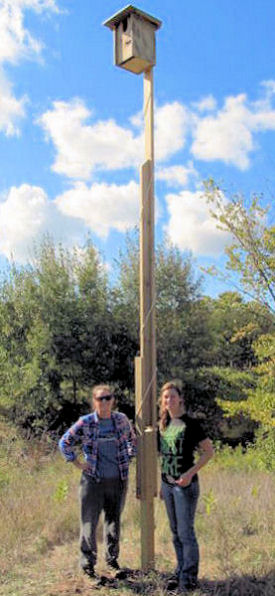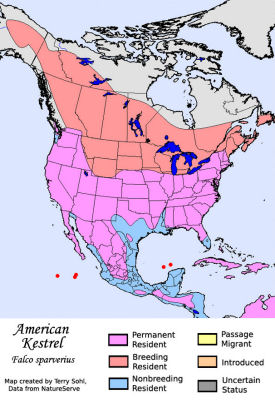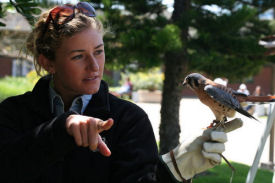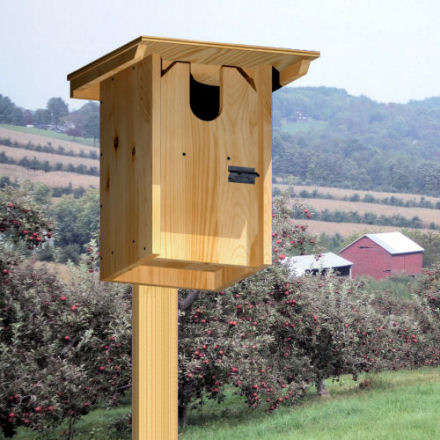
The Spartan
A nestbox for the American Kestrel
By Tom Comfort
In 2012, I participated in a special project with Michigan State University graduate students studying Kestrels in NW Lower Michigan. Most of the Kestrel nestbox designs I first considered for the project were much like oversized Bluebird boxes of long ago that we have since learned how to improve to better protect nestlings from weather and predators. I was interested in going beyond those traditional designs and I wanted to add other features that veteran Kestrel nestbox builders had refined over many years. The Spartan nestbox, named after the MSU mascot, is the result.
A nestbox for the American Kestrel
By Tom Comfort
In 2012, I participated in a special project with Michigan State University graduate students studying Kestrels in NW Lower Michigan. Most of the Kestrel nestbox designs I first considered for the project were much like oversized Bluebird boxes of long ago that we have since learned how to improve to better protect nestlings from weather and predators. I was interested in going beyond those traditional designs and I wanted to add other features that veteran Kestrel nestbox builders had refined over many years. The Spartan nestbox, named after the MSU mascot, is the result.
Featured Nestbox

The American Kestrel

North America's littlest falcon, the American Kestrel packs a predator's fierce intensity into its small body. It's one of the most colorful of all raptors: the male's slate-blue head and wings contrast elegantly with his rusty-red back and tail; the female has the same warm reddish hue on her wings, back, and tail. Hunting for insects and other small prey in open territory, kestrels perch on wires or poles, or hover facing into the wind, flapping and adjusting their long tails to stay in place. Kestrels are declining in parts of their range; you can help them by putting up nest boxes.
Size & Shape
The slender American Kestrel is roughly the size and shape of a Mourning Dove, although it has a larger head; longer, narrow wings; and long, square-tipped tail. In flight, the wings are often bent and the wingtips swept back.
Color Pattern
American Kestrels are pale when seen from below and warm, rusty brown spotted with black above, with a black band near the tip of the tail. Males have slate-blue wings; females' wings are reddish brown. Both sexes have pairs of black vertical slashes on the sides of their pale faces-sometimes called a "mustache" and a "sideburn."
Behavior
American Kestrels usually snatch their victims from the ground, though some catch quarry on the wing. They are gracefully buoyant in flight, and are small enough to get tossed around in the wind. When perched, kestrels often pump their tails as if they are trying to balance.
Habitat
American Kestrels occupy habitats ranging from deserts and grasslands to alpine meadows. You're most likely to see them perching on telephone wires along roadsides, in open country with short vegetation and few trees.
Article reprinted with permission from the Cornell Lab of Ornithology
Size & Shape
The slender American Kestrel is roughly the size and shape of a Mourning Dove, although it has a larger head; longer, narrow wings; and long, square-tipped tail. In flight, the wings are often bent and the wingtips swept back.
Color Pattern
American Kestrels are pale when seen from below and warm, rusty brown spotted with black above, with a black band near the tip of the tail. Males have slate-blue wings; females' wings are reddish brown. Both sexes have pairs of black vertical slashes on the sides of their pale faces-sometimes called a "mustache" and a "sideburn."
Behavior
American Kestrels usually snatch their victims from the ground, though some catch quarry on the wing. They are gracefully buoyant in flight, and are small enough to get tossed around in the wind. When perched, kestrels often pump their tails as if they are trying to balance.
Habitat
American Kestrels occupy habitats ranging from deserts and grasslands to alpine meadows. You're most likely to see them perching on telephone wires along roadsides, in open country with short vegetation and few trees.
Article reprinted with permission from the Cornell Lab of Ornithology
Nestbox Features
The EntryDesigners on the east coast were finding that a vertical 3 x 4 inch oval entry proved to be an advantage over the traditional 3-inch round in attracting Kestrels. Since Steve Gilbertson had amazing success with a similar entry on the Gilwood Bluebird nestbox, and Dick Peterson spent years developing an elongated entry for the Peterson nestbox, I thought the idea worth a try.
Venting
The venting of a Kestrel nestbox has always been minimal, and I have not found any research indicating this to be a problem. However, I knew Kestrels are in the box for a month, and possibly during peak warm summer days. But I also knew the hazards of side vents with exposure to wind driven rain. The Gilwood style entry would help ventilate the box, plus I added cut off corners on the front panel to vent the edges of the nesting cavity as well. All of the venting is now on the front of the box, which will better protect the nestlings.
Inner Roof
The inner roof, which started with Dick Peterson's design, has always been a favorite of mine. It protects the nestbox from the warm sun shining on the roof, and also helps seal out rain by providing more constructive sealing around the upper parts of the nestbox under the main roof.
Recessed Door
The sides of the Spartan extend past the front entry panel to protect the opening from wind and rain. This is another feature of Steve Gilbertson's Gilwood (which was actually an improvement by accident and not by design, according to Steve).
Other Features
With an entry-to-floor drop of 9 1/2" and a 78 square inch floor, the nesting cavity is a little more spacious than traditional boxes. To keep rainwater from migrating under the roof, side and rear drip rails were added. I also had to consider that the MSU students would be monitoring the nestboxes so I added a secure door latch to make their experience easier and to help secure the nestlings.
The Nestbox Mounting Tower
The Nestbox Mounting Tower is made from standard sized lumber and readily available hardware. It will place the nestbox up to 18 feet high, depending on lumber lengths selected. The main pole pivots from horizontal to vertical, allowing the box to be raised or lowered without the use of a ladder. The original Spartan plan incorporated a swivel to keep the nestbox more or less level while raising and lowering. I am in the process of improving the swivel device and plans will be published soon.Field Testing
March 2012 was our first opportunity to see how things worked. The first eight nestboxes installed in Leelanau county for the MSU project had 7 successful Kestrel nestings. We installed two more boxes last summer in another location and plan 14 more Spartan nestboxes and towers for 2013. Field testing of the Tower mounting pole was done on my property some years ago. I located a traditional Kestrel box on the new Tower design and left it in the wind and elements,... until I decided that it would work just fine (and my wife tired of it).Kestrel Habitat
Kestrels are attracted to open spaces with sparse ground cover, similar to Bluebirds. Because Kestrels are quite fond of rodents, vineyards, which attract voles that eat vine roots, and orchards that attract mice, are prime habitats. Kestrels also enjoy eating grasshoppers, which are usually abundant in both these habitats.A high perch within the habitat is desirable. In orchards and vineyards, we located the boxes on higher hills to make the boxes themselves the highest point. We are considering separate hunting perches at distances from the nestboxes to help Kestrels expand their hunting range past the orchards and vineyards.
The challenge often is to locate a Kestrel nestbox to attract the Kestrel pair but to avoid Starlings. In the 2012 project for MSU, we avoided Starling competition by also avoiding forested land or even small groups of trees that Starlings prefer.
Nestbox Mounting Height
I have learned there is quite a variety of Kestrel box mounting heights that seem to be successful. Some are mounted as low as eight feet on the back of highway signs, while many Kestrel nestbox gurus mount boxes no less than 18 feet. Perhaps the deciding factor is whether there is a suitable high perch (like a power line) nearby. The lack of a natural high perch may mean the box has to be the high point.Another factor is the ability to safely reach the nestbox for monitoring and maintenance. The nestbox Tower mount solved this problem.
Nestbox Spacing
Kestrels will travel a fair distance in search of food, so box spacing from one quarter to one half mile should help males avoid the need to defend territory and matesMonitoring
The students from MSU did a remarkable job monitoring the nestboxes in 2012 and I was quite impressed that they were so successful in relocating nestboxes and poles when necessary. Many farmers who host Kestrels as part of their orchard or vineyard management do not monitor the nestboxes during the summer. We do encourage them to clean the boxes and provide fresh wood chips or shavings for the nesting base well before the Kestrels return.Predator Guards
Preventing climbing predators from reaching the nestbox is essential in most areas. So far, raccoons have not succeeded in climbing the main pole of the mounting tower. However, we are not going to take any chances. Currently we are trying the metal stovepipe baffle or large diameter PVC pipe around the 2x4 main pole of the tower mount. Once you put up a nestbox, you also assume responsibility to protect the birds you are trying to help.Other species in the Spartan
Both the overall size of the Spartan, and its entry, are the correct size for both Screech Owls and Saw Whet owls. Mounting location and method for these species would be different, as the habitat preferred by Kestrels may not be suitable for other species.In conclusion, it appears the Spartan has proved to be a good box that will protect nesting Kestrels and is apparently quite attractive to them as well. I look forward to learning of the experiences of others when using this nestbox, and hope they accept the responsibility that comes with providing nestboxes anywhere.
The Spartan is a front opening nestbox designed specifically for the American Kestrel. Below, graduate students from MSU with the Spartan mounted on a specialized pole - the Nestbox Mounting Tower.





Home | Site Map | Disclaimer | Contact Us
Copyright © 2012 NestboxBuilder.com
This site was last updated on 01/01/2016
Copyright © 2012 NestboxBuilder.com
This site was last updated on 01/01/2016


